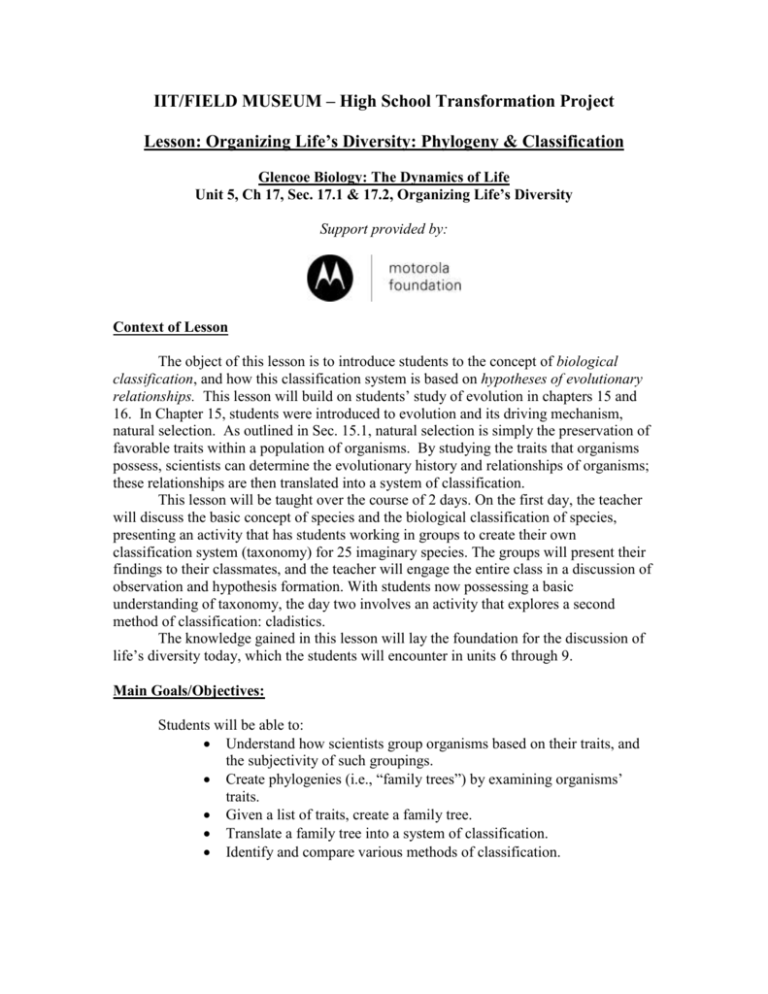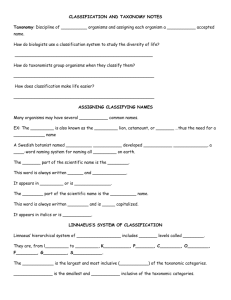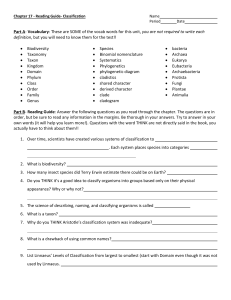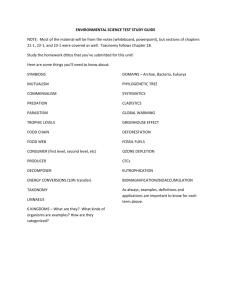Organizing Life's Diversity: Phylogeny & Classification
advertisement

IIT/FIELD MUSEUM – High School Transformation Project Lesson: Organizing Life’s Diversity: Phylogeny & Classification Glencoe Biology: The Dynamics of Life Unit 5, Ch 17, Sec. 17.1 & 17.2, Organizing Life’s Diversity Support provided by: Context of Lesson The object of this lesson is to introduce students to the concept of biological classification, and how this classification system is based on hypotheses of evolutionary relationships. This lesson will build on students’ study of evolution in chapters 15 and 16. In Chapter 15, students were introduced to evolution and its driving mechanism, natural selection. As outlined in Sec. 15.1, natural selection is simply the preservation of favorable traits within a population of organisms. By studying the traits that organisms possess, scientists can determine the evolutionary history and relationships of organisms; these relationships are then translated into a system of classification. This lesson will be taught over the course of 2 days. On the first day, the teacher will discuss the basic concept of species and the biological classification of species, presenting an activity that has students working in groups to create their own classification system (taxonomy) for 25 imaginary species. The groups will present their findings to their classmates, and the teacher will engage the entire class in a discussion of observation and hypothesis formation. With students now possessing a basic understanding of taxonomy, the day two involves an activity that explores a second method of classification: cladistics. The knowledge gained in this lesson will lay the foundation for the discussion of life’s diversity today, which the students will encounter in units 6 through 9. Main Goals/Objectives: Students will be able to: Understand how scientists group organisms based on their traits, and the subjectivity of such groupings. Create phylogenies (i.e., “family trees”) by examining organisms’ traits. Given a list of traits, create a family tree. Translate a family tree into a system of classification. Identify and compare various methods of classification. General Alignment to Standards: State Goal 11. Understand the processes of scientific inquiry and technological design to investigate questions, conduct experiments and solve problems. A. Know and apply the concepts, principles and processes of scientific inquiry. ILS 11.A.4a Formulate hypotheses referencing prior research and knowledge. State Goal 12. Understand the fundamental concepts, principles, and interconnections of the life, physical and earth/space sciences. A. Know and apply concepts that explain how living things function, adapt and change. ILS 12.A.4c Describe processes by which organisms change over time using evidence from comparative anatomy and physiology, embryology, the fossil record, genetics and biochemistry. State Goal 13. Understand the relationships among science, technology and society in historical and contemporary contexts. A. Know and apply the accepted practices of science. ILS 13.A.4c Describe how scientific knowledge, explanations and technological designs may change with new information over time (e.g., the understanding of DNA, the design of computers). Materials: Day One Transparency of imaginary species Day Two Harris Loan Center Exhibit Cases: One Mammal One Bird One Invertebrate (animal without a backbone) One Plant Internet access to play Evolving Planet “Phylogeny” video clip (Windows Media Player required to view clip) Vocabulary binomial nomenclature cladistics cladogram classification evolution phylogeny taxonomy taxonomic rank Kingdom Phyla Class Order Family Genus Species Venn diagram Facilitation: This lesson requires two complete class periods for the activities and discussion. Day 1 Introduction to Classification; Taxonomic Ranks (45 minutes) The objective of Day 1 is to introduce students to the concept of biological classification, or taxonomy. Using illustrations and specimens from The Field Museum’s Harris Loan Educational Program, students will create classification systems of their own. This activity will build on the students’ study of evolution in Chapter 15. By studying the traits that organisms possess, scientists can determine the evolutionary history and relationships of organisms; these relationships are then translated into a system of classification. Materials: Transparency of imaginary species Lesson Overview: 1. Begin with Bell Ringer; 2. Review the concept of species, and then present the information on the history of taxonomy; 3. Discuss Linnaeus and the concept of taxonomic ranks; this discussion will provide the necessary information to perform the activity; 4. Have students participate in activity of creating their own classification scheme of taxonomic ranks; 5. Compare the results obtained by the students, and follow with an important discussion of subjectivity as an aspect of the scientific process. Lesson Details: Bell Ringer Ask the students to think of two different species of animals and then list at least five characteristics of each. Encourage students to try to answer the question even if they are not sure about it; Bell Ringers will be used to get students to begin THINKING about the topic of the day! Instead of having the students come up with the species on their own, the teacher can also show the students a transparency illustrating two different species, such as Pan troglodytes (chimpanzees) and Homo sapiens (modern humans), and then ask them to list at least five characteristics of each. Do not discuss answers to these questions now. Begin lesson by reminding students that a species is a group of organisms that can interbreed and produce fertile offspring in nature (this definition was covered in Chapter 1, Section 1.1 of the Glencoe Biology text). Scientists have identified nearly 2 million species that live on Earth today. To help organize and better understand this immense diversity, they have developed ways to classify—or group—organisms based on similarities that they share. The branch of biology that groups and names organisms based on studies of their different characteristics is called taxonomy (tak SAH nuh mee). Students will be classifying organisms by DOING science in the same ways scientists do their work. During these investigations we will raise questions that we can answer by collecting information/data so that we can analyze and draw conclusions that will help us understand how the natural world works. Briefly review the history of taxonomy presented on pages 443-445 of the Glencoe Biology Text. Aristotle was the first to develop a widely accepted system of classification; although very simple, his classification system was based on the same principle as is used today: grouping organisms based on their characteristics. Carolus Linnaeus is often called the Father of Taxonomy; he developed a classification system that is still used today. Like Aristotle, the Linnean system of classification is based on the grouping of organisms by looking at the characteristics of organisms. Linnaeus also developed a two-word naming system called binomial nomenclature. In this system, species’ names consist of two words (these two words are usually Greek or Latin). The first identifies the genus of organism; a genus is a group of closely related species. The second is the specific epithet. Thus, the scientific name for a species: 1) must always include the genus name and the specific epithet; and 2) is always italicized (or underlined). For example, the modern human species is Homo sapiens (Latin for “wise man”). The species Homo sapiens belongs to the genus Homo. Other examples of species names: Common Name Scientific Name Lions…………………Panthera leo Tigers…………….…..Panthera tigris Army ants……………Eciton burchelli Leaf cutter ants………Atta sexdens Red maple tree……….Acer rubrum Gut bacteria………….Eshcerichia coli Explain the system of classification based on taxonomic ranks (pages 447-450 of the Glencoe Biology text), covering the kingdom-phylum-class-order-family-genus-species system of hierarchy. In addition to the example provided on page 449, see the attached example using humans and bacteria (Table 1); this table can be used as a handout or a transparency. Divide the students into small groups of four or five. Show the transparency of the 25 imaginary species (or hand out photocopies to each group). Ask the students to group these species—based on their physical characteristics—into different genera, families, classes, orders, and phyla. In doing so, they will be practicing taxonomy! ACTIVITY NOTES: 1) To help them begin, you can tell the students that all species are animals, so we know that they are grouped within the Kingdom Animalia. 2) Because these are imaginary species, the names of the genera, families, etc. can be made up by the students. 3) In addition to just grouping the animals as they see fit, be sure to have the students note the characteristics that define each genus, family, etc. Once they are finished, lead the groups in a discussion on their different classification schemes. Ask the groups how and why they classified the species as they did. IMPORTANT: It is very likely that the different groups will produce different classification schemes. This is okay because there is no right answer! Even though the groups created their classification using the same method (by looking at the characteristics of the species), their results will depend on what characteristics they used to group/classify the species. Thus, biological classification is very subjective; so it’s a wonderful opportunity to discuss the subjectivity that is a part of the nature of science! Day 2 Cladistics (45 minutes) During Day 1, students were introduced to: 1) the concept of biological classification, or taxonomy; and 2) using taxonomic rankings to classify species. The objective of Day 2 is to introduce a second method of classification, cladistics. As outlined on pages 452-453 of the Glencoe Biology text, cladistics is a method that classifies organisms based on their phylogeny, or evolutionary history. Like the classification system using taxonomic ranks, scientists that use cladistics look at the characteristics that organisms possess. But unlike the system of taxonomic ranks, cladistics produces a type of family tree called a cladogram that shows how the different species are related to each other. Materials: Cladogram Worksheet Harris Educational Loan Center Exhibit Cases: One Mammal One Bird One Invertebrate (animal without a backbone) One Plant Internet access to play Evolving Planet “Phylogeny” video clip (Windows Media Player required to view clip) Lesson Overview: 1. Introduce cladistics (pages 452-453 of the Glencoe Biology text) and reinforce this information by showing a video clip from the Evolving Planet Web-site; 2. Lead an activity that uses dinosaurs to show how a cladogram is made; 3. Have students use the same technique to create a cladogram based on the specimens from the Harris Educational Loan Program; 4. Emphasize how cladistics differs from using taxonomic ranks (the method used during Day 1). Lesson Details: Introduce the concept of cladistics to students using the information presented on pages 452-453 of the Glencoe Biology text. Show students the “Phylogeny” video clip from the Evolving Planet website (http://www.fieldmuseum.org/evolvingplanet/mesozoic_21.asp) to reinforce students’ understanding of phylogeny and how scientists create cladograms. Lead a discussion on how to create a cladogram. This exercise will demonstrate how to make the family tree shown in figure 17.7 (page 452) of the Glencoe Biology text. Use the provided data table (Table 2) and follow these steps: 1) In the data table, place an “x” in the box in the organism has the characteristic. Complete the table as follows: Trait Light bones Wishbone; Three-toed foot Down feathers Feathers with shaft, veins, and barbs Flight feathers; Arms as long as legs Allosaurus X Sinornis X Velociraptor X Archaeopteryx X Robin X X X X X X X X X X X 2) Based on the information in the data table, create a Venn diagram, placing the animals in groups to illustrate the characteristics that they have in common: This diagram shows a “nesting” of characteristics, which is based on the distribution of characteristics shown in the data table. For example, all of the dinosaurs with flight feathers and arms as long as legs also have feathers with a shaft, vein, and barb; down feathers; a wishbone and three-toed feet; and light bones. As another example, all of the dinosaurs with down feathers have a wishbone and three-toed feet; and light bones. 3) Write the name of the dinosaurs in the appropriate sections of the diagram. For example, Allosaurus has light bones but none of the other features, so it belongs in the outer most box; Sinornis has light bones and a wishbone and three-toed foot, so it belongs in the next box; etc. The complete diagram should look like this: 4) Now that the dinosaurs have been mapped onto the diagram, they can be connected with lines to make a family tree, or cladogram, like that seen in figure 17.7 (page 452) of the Glencoe Biology text. The characteristics can be shown on the diagram, too: Tell the students that now they’ll make their own cladogram, using the specimens in the Harris Educational Loan Program cases or boxes. Distribute copies of Table 3. You may want to do the first trait (“Composed of eukaryotic cells”) with the students; all of the organisms listed are composed of eukaryotic cells, so all organisms will have an “x” in that row. Instruct the students make the remaining determinations by looking at the specimens in the Harris Educational Loan Program cases or boxes. Although the animals are no longer living, and therefore don’t move, students will have to look at the organisms for evidence that they move, such as legs, for the second trait in the table. From the data table, they should be able to construct a Venn diagram and a cladogram. The complete table should look like this: Trait Plant Composed of eukaryotic cells Heterotrophs that move at some point in their lives Possess backbone Possess hair & produce milk to nurse their young X Invert Bird Mammal X X X X X X X X The complete Venn diagram should look like this: X The complete cladogram should look like this: Reinforce that all classification systems, whether it’s taxonomic ranks (Day 1 of lesson) or cladistics (Day 2 of lesson), are based on the features that organisms possess. Those that possess similar features are grouped together, and these features not only include physical traits that you can see with the naked eye, but also other features (e.g., mating calls and DNA). At The Field Museum’s Pritzker Laboratory for Molecular Systematics and Evolution, scientists analyze DNA to determine how organisms are related and how they should be classified; if time permits, see http://www.fieldmuseum.org/research_collections/pritzker_lab/pritzker/index.html for information on the scientists and their studies. Also, note the major difference between taxonomic ranks and cladistics. Taxonomic ranks are based on sorting by features only; no consideration of time and evolutionary relationships are considered. Cladistics, on the other hand, is based on first constructing an evolutionary tree; once the tree is complete, then a classification is made. Also, the tree shows how organisms evolved over time; the oldest branching is that at the bottom, while that at the top is the most recent (e.g., in the above example, the branching to the invertebrate happened before the branching that led to the bird and mammal). Teacher Resources: Related Exhibitions at The Field Museum: Evolving Planet What is an Animal? Plants of the World World of Mammals Web-sites: Carl Linnaeus: http://www.ucmp.berkeley.edu/history/linnaeus.html Taxonomic Ranks: http://en.wikipedia.org/wiki/Linnaean_taxonomy Cladistics: http://tolweb.org/tree/phylogeny.html http://www.ucmp.berkeley.edu/clad/clad4.html TABLE 1. Examples of Taxonomic Ranking Humans Western Gorilla Bobcat Gut Bacteria Pneumonia-causing Bacteria Kingdom Animalia Animalia Animalia Bacteria Bacteria Phylum Chordata Chordata Chordata Proteobacteria Firmicutes Class Mammalia Mammalia Mammalia Gamma Proteobacteria Bacilli Order Primates Primates Carnivora Enterobacteriales Lactobacillales Family Hominidae Hominidae Felidae Enterobacteriaceae Streptococcaceae Genus Homo Gorilla Lynx Escherichia Streptococcus Species Homo sapiens Gorilla gorilla Lynx rufus Escherichia coli Streptococcus pneumoniae




